What if I told you that it is possible to make a living from a 4-acre orchard and you can even do this with less work, more yield and more fun.
What if I told you that the secret to doing this is already known, but the information about how to go about it has not reached you?
I wrote about Stefan previously, but his model deserves in-depth explanation. His orchard took 22 years to establish and to be honest it wasn’t always rosy for Stefan.
He is a pioneer of permaculture orchards, and now he shares his knowledge so you do not need to go through 20 years of trial and error like him. You can learn from his experiences so that you don’t make the same mistakes he did. Learning from his experiences means you can save time and money.
But before we go any further here are few things to consider about Stefan:
- He bought his 5-hectare block and 4000 trees for $42000 – he had no debt, no mortgage and no money left to do anything
- He had very little farming experience when he started his farm – he did however, have a formal education that helped him
- Stefan does not live on his farm – he actually lives in the city and commutes to his farm from home.
- He had many setbacks along the way that would make most people quit, but he persisted, and now his farm is successful.
Miracle Farms: Stefan Sobkowiak – A 4 -acre Commercial Permaculture Orchard, 22 Years in the Making
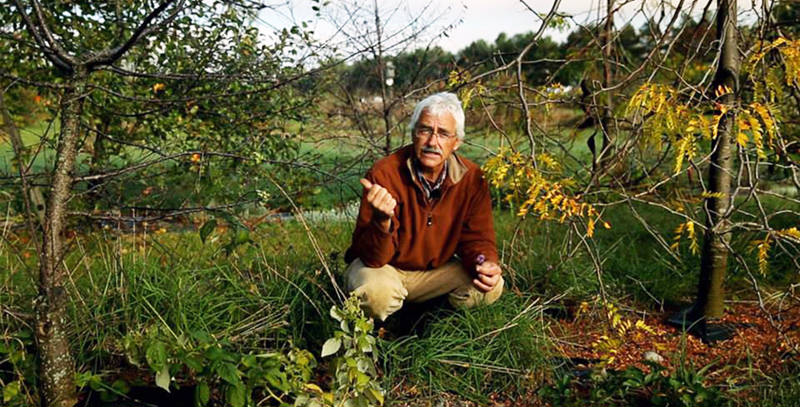
Stefan Sobkowiak, founder of Miracle Farms
Stefan Sobkowiak is an educator, biologist and master of landscape architecture. He has taught fruit production, landscape plants and design, and the natural history of vertebrates at Montreal’s McGill University. This experience helped a lot when he decided to focus on Permaculture Design and his ‘Miracle Farms’.
The farm that he bought was originally developed as a commercial monoculture apple orchard, making the transition to becoming an organic farm upon purchase in 1993, and was certified organic in 1996. Eventually, Stefan understood the limitations of the organic model originating from monoculture. Since 2007, four acres were converted to a permaculture inspired “u-pick” orchard.
Miracle Farms is the largest and the most developed example of a commercial permaculture orchard in Eastern North America. Production from the farm is sold to 30-80 member families with the short term goal of reaching 100 families.
Recently with film maker Olivier Asselin, Stefan released a DVD called The Permaculture Orchard: Beyond Organic. This is a feature-length educational film that teaches how to set up your own permaculture orchard on any scale. Stefan has this to say about the film – “It will really save you 10 years at least of trial and error and thousands of dollars. Don’t reinvent the wheel, take what I learned and build on it .”
So let’s dive in and see what you can learn from Stefan’s model.
The Permaculture Orchard Model
1. Location and Size

Les Fermes Miracle Farms, about one hour southwest of Montreal.
Les Fermes Miracle Farms is about one hour southwest of Montreal, roughly 100km away, in Cazaville, Quebec, Canada. It’s Canada’s warmest climate zone -Agriculture Canada Zone 5b: USDA zone 4. The property is 12-acres in size with approximately 4 acres planted in a Permaculture style orchard.
The location of the farm is very important. As with many models I have described before, Miracle Farm is located relatively close to the target market, in this case close to the million-and-a-half people living in the city of Montreal.
Although the original idea was 30 minutes away from Montreal, which is an ideal distance for clientele membership club according to Booker T. Whatley’s Handbook on How to Make $100,000 Farming 25 Acres, after many years of searching Stefan settled for a farm twice that distance from Montreal but still managed to make his farm a success.
What Stefan learned was this: If you are close to city there is not such a need to diversify but if people invest their time and visit your farm that is further away, you need to offer them something more that is worth the visit. That is exactly what Stefan did.
2. On-site Permaculture Nursery
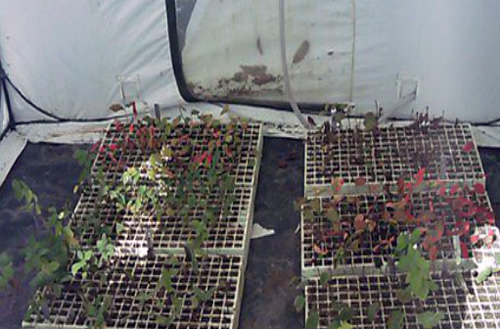
Start a nursery!
Stefan needed a lot of trees for his new orchard, although there were 4000 apple trees in the orchard already, in the first two years of owning the farm he sadly lost 1000 of them. The cost of the trees accounts for more than 50% of the costs of an orchard so to decrease his expenditure Stefan set up nursery project so that he could grow his own trees.
While teaching at McGill University Stefan partnered with one of his students who wanted hands-on experience and started a tree nursery on the farm. In return for his help, Stefan agreed to split the trees they produced between them 50:50. They tilled a 12x23m area (276m squared), made 3 rows and planted rootstock to be grafted later.
So think about it, if you want to start a permaculture orchard, you could plant a nursery ahead of time by using 10ftx10ft (3mx3m) spot in your back yard. Plan now, gather your mother plants from which you will be able to take cuttings or scions for grafting, contact people in your area that are doing similar projects and learn from them. You could grow just below 1000 trees in that small area (If you have trees in each of the pots you should yield 900 trees).
As Stefan said: “There is a tremendous motivating force to find a piece of property once you have a nursery full of plants that will soon need to be transplanted.”
3. Trios Design Pattern
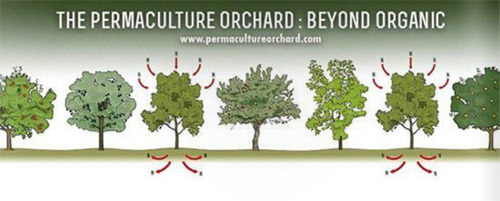
Each fruit tree is next to a nitrogen fixer
What’s unique about Stefan’s orchard is that it is planted in Trios (originally called NAP – nitrogen fixer, apple, and plum/ pear), One nitrogen fixer, 2 crop trees. This is very similar to David Holmgren’s European style permaculture orchard where he interplants with tagasaste (tree lucerne), also a N – fixer. One characteristic of this pattern is that no fruit or nut tree is next to its own species in the row or in between the rows. Therefore, if any tree gets infested with pests, it is much less likely to pass the problem on to another tree of its kind.
Although 1/3 of the orchard aren’t fruiting trees, mixing in nitrogen fixing trees among fruit trees is essential because it helps to create fertility and eliminates the need for external inputs of fertilisers, resulting in a circular ecosystem that virtually takes care of itself. Amazingly, there was no fertiliser used on Stefan’s orchard since 2007 and the fruit trees keep on giving as much yield as conventionally grown trees. N – fixers in Stefan’s case are Honey Locusts and they also act as trellising for vines, kiwi and grapes.
The primary goal is to increase diversity whilst providing a diversity of crops and to reduce or eliminate the use of fertilisers and pest and disease control products. This orchard now offers over 80 cultivars of apples, in addition to several types of plums, pears, cherries, and countless other fruits and vegetables. There are also trios in shrubs: red, black currants, honeysuckle, gooseberry, raspberry, and rhubarb; as well as over 100 different types of ground cover such as annual vegetables, herbs and grasses.
With this hugely diverse amount of crops, trees, bushes, shrubs and plants, you might wonder how Stefan makes sense of the countless plants growing. There is one more ingredient to this design.
4. Grocery Store Concept

The permaculture grocery store
While trios (NAP) design is 3D pattern in Stefan’s orchard there is also the fourth dimension that is simply: Time.
In permaculture orchard everything is organised by following what Stefan calls a ‘grocery aisle’ concept, whereby everything in one row will be ripe and ready to harvest within a 10-day window.
Despite the huge diversity of species, this allows for efficient harvesting, customers can walk down the row and easily gather the majority of the fruits and vegetables they require in one go, just like they would in the grocery store.
This also helps bring order to the high diversity madness of 100 cultivars of fruit & nut trees, dozens of small fruit shrub cultivars and over 100 species of companion plants. Stefan also aims for a complete season of harvest without any spaces when there will be nothing to harvest. Harvest dates are key to a successful ‘grocery aisle’ planting- Ideally you need to aim for 3 periods of 10-day harvests per month.
While conventional orchards also use the idea of multiple harvest dates because labour is one of their biggest expenses, Stefan is able to keep his labour costs even lower. How? All the lower parts of the tree fruit picking is done by his customers! Leaving the tops of trees to be picked with ladders.
5. CSA/U-pick operation – Costco Style Membership
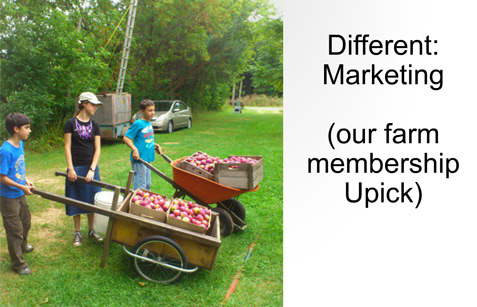
Over the years, Stefan has built up a customer base that is willing to come and pick the produce themselves, thus cutting down on labour costs. He said:“The greatest single cost for most fruit production is harvesting and packaging, usually 40% of the total costs. If people harvest their own in their own containers, we can pass on some of the savings and still earn a better return for our efforts.”
His business model is a members only U-pick operation – basically the same as a Costco membership. For those living outside the USA, UK or Australia, Costco is an American membership-only warehouse club that provides a wide selection of merchandise at low prices, but membership must be purchased in advance for one year. In Stefan’s case members pay an annual fee of $55 which entitles them to come and pick at all of his open days. They can also attend the tours for free and order meat that Stefan also produces. They also get $20 redeemable towards their purchase as part of their membership and benefit from getting fresh, beyond organic food for up to 50% less than what they might buy in the supermarket. Non- members cannot pick any fruit, or buy meat, they may be able to buy from a small roadside stand at twice the U-pick price when Stefan has extra produce.
Stefan also makes sure to use one of the most powerful words in the world of marketing: NO. He often says this in response to people who would like a one-off experience on the farm. This makes his farm an experience limited the group of people who have chosen to be members and are opting for an experience and not just passing by. This way Stefan can provide value to his customers and better convey and inform members of what foods they have. He can tell the ongoing story about his orchard, as well as its history, and educate his members.
Stefan did not always work this way. Initially, he started selling to the public and built up a customer list of satisfied buyers. Stefan said: “A list of satisfied buyers is worth gold.” Later on he converted to the paid membership model, and a lot of those existing customers signed-up.
6. Innovations in the Management of the Orchard
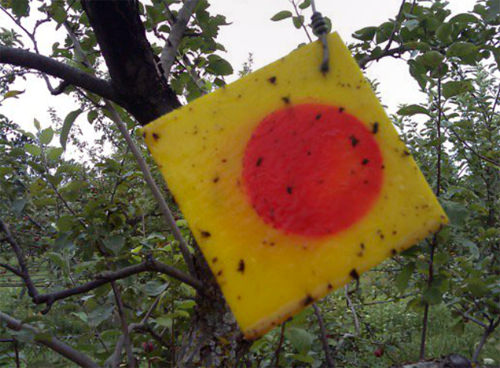
An apple maggot fly trap (Rhagoletes)
Do you know how many plants Stefan has on 1 acre of land? If we look at the figures it is – 450 trees, a minimum of 450 shrubs, 16×450 = 7200 perennials + ground cover, 150 vines, this is total of a minimum of 8250 plants. And this is just in 1 acre of land. Stefan has 4.
How can one man maintain this many plants, prune all of his the trees and not even live on the farm? There must be a secret.
Stefan was clever enough and open-minded enough to embrace novel methods of caring for his trees. This enabled him to do 80% less work when it came to pruning- although it would be more accurate to say training rather than pruning. He still prunes his trees but only the branches that actually shape the tree, i.e. doing steps to have a chimney to a tree, keeping only 12 -14 branches and pruning or maintaining every branch he keeps. He learned a lot from various French horticulturists in the compiled book Growing Fruit Trees: Novel Concepts and Practices for Successful Care and Management.
On top of that he uses whey to displace fungi diseases, uses insect traps containing molasses and creates favourable habitats for his wildlife that will help protect his trees and plants..
His methods are innovative and he innovates and experiments all the time. He does still use some conventional orchard methods for doing things, such as using plastic mulch and irrigation pipes. To have a better understanding of his whole method of Permaculture Orchard I would encourage you to watch the film where he fully explains his methods and reasons for doing them.
7. Income from Diversification and Stacking function
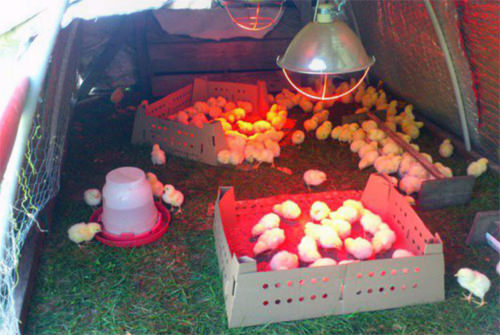
Stacking functions – Raising poultry on grass in the aisles
Although the main crop is fruit, fruit alone would not be enough to earn Stefan a decent income. It is also important to note that in farming you do not get to decide which year will be a good harvest. Stefan knows a lot about farming but he is not the boss the Mother nature is, so there can be years with a low fruit tree yield, which when it is your main crop is a big problem. The answer to maintaining a sustainable income in bad harvest years is like in investing, you don’t invest all your money in stocks and put all of your eggs in one basket, you must diversify and be consistent with production, when people come have something else to offer besides your primary crops.
Making a profit on an acre is stacking functions of apples, pears, vines, herbs, as well as keeping animals that graze in the grassy lanes. The grassy lanes are used for pasture (as Mark Shepard does). In these lanes, he raises chickens, turkeys, guinea fowl, ducks and geese. The farm is used as a continuing education lab for students in the permaculture courses, offering workshops (grafting, pruning, nursery propagation, raising small fowl, processing fowl) as well as for interns. Farm tours are also available for groups. Here is the full income breakdown.
Farm Income:
- Sale of Produce and Products – 70%
– Herbs, Flowers, Fruit Trees & Berries, Vegetables, Traps.
– Meat birds.
– Added value products: Juices from apples, dried fruit - Education – 20%
– PDC, Workshops
– DVD - Consultancy Service = 2%
- Tours of the farm – 8%
Just note that the exact figures of farm income vary from year to year. As Stefan remarks: “ Last year was dismal with no tree fruit, although the best year for small fruit. So last year was a reversal with education and tours making up 70% and sale of produce and products 20% . It’s great to have a diversity of yields to balance things out from year to year.”
8. Learning-Oriented Mindset
If you came this far, you my friend are a keen learner and this is a lesson for you. None of the success Stefan had after 20 years of hard work would be possible without embracing a learning mentality. With so many setbacks and mistakes, many ordinary people would quit a project like Stefan’s, as the owner from whom Stefan bought his orchard did. But, as they say in Permaculture: “there are no mistakes, only feedback”, Stefan accepted that feedback and kept moving along.
He said:”I was a near total newbie respecting orchards when we bought a 4000 tree conventional apple orchard. Began the conversion to organic, immediacy lost 1000 trees first 2 years. (Ouch) Learned a whole lot.”
Stefan recommends in the beginning seeing what other people are doing, learning from their mistakes and building upon their good designs. He recommend to start and then visit other farms and doers to see first-hand how things are done and to have a reference point for what you’re doing.
When he started he visited Joel’s Polyface farm and others, read books and kept trying new things and innovating on his own farm. Traveling and seeing what other farmers were doing was eye-opening and taught Stefan a lot.
Conclusion
It took 22 years for Stefan to reach the point where he is today and his road to success was paved with many setbacks and many learning experiences. Now everything he learned is readily available. So, watch his film, read his book and read Q&A following the release of the film. Everything is there you just need to act on it.
If you want to provide a more natural environment, free from the artificiality of monoculture and welcome natural allies to do their jobs, if you want a greater yield of produce and more fun, with less work- then interplant with nitrogen fixers and increase plant diversity through different species and different cultivars. To put it simply there are four steps to establishing a permaculture orchard – 1.trees, 2.shrubs, 3.companion plants (perennials, herbs, vines) 4.allies. But there is much more to it if you want to adopt permaculture orchard model and adapt it to your situation.
- Don’t reinvent the wheel, take what Stefan learned and build on it – save yourself time and money.
- Location is very important – the ideal location if you have produce to sell, is 30 min from the population centre and on the main road, but you can make it work if you have to be based further away.
- Grow your own trees to help reduce costs and motivate yourself – if you can, partner up with someone with skills and split the final trees.
- Create Trios – interplant with nitrogen fixers and increase plant diversity through different species and different cultivars.
- Use grocery store concept – windows for harvesting, same cultivars in the same row, while understory is growing all year.
- Start a CSA/U-pick operation – Costco style membership – members harvest so you don’t have that expense. As much as 40% of conventional fruit growing expenditure is spent on harvesting and containers.
- Embrace novel methods of maintaining trees to save time and keep your orchard beyond organic with innovative methods of pest control.
- You want to be consistent with production- to do that diversify. When people come have something else to offer besides primary crop.
- Making a profit on an acre is stacking functions of apples, pears, vines, herbs, and animals grazing in grassy lanes.
- Never stop learning and trying. Period!
Stefan’s vision for the Permaculture Orchard is: 1000 hectares, 1000 people in 50 countries. Do you feel inspired to join his vision? Let me know in the comments!
First published here.



